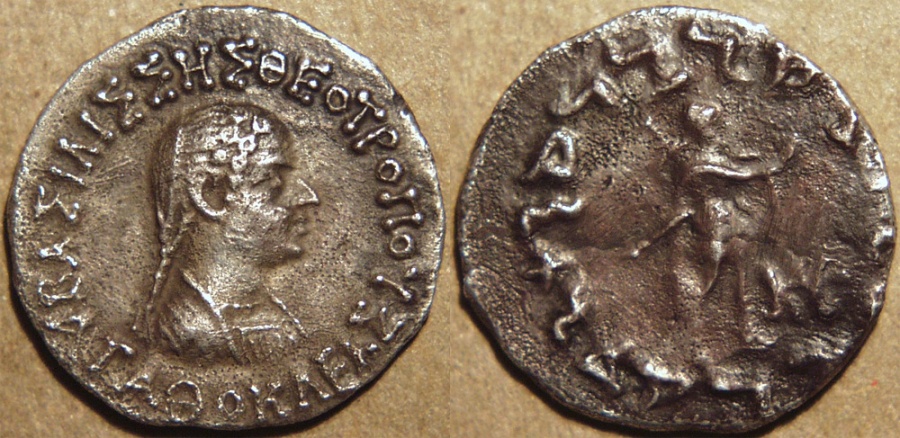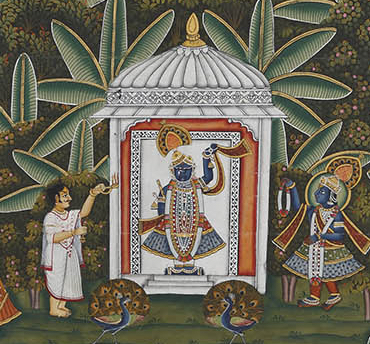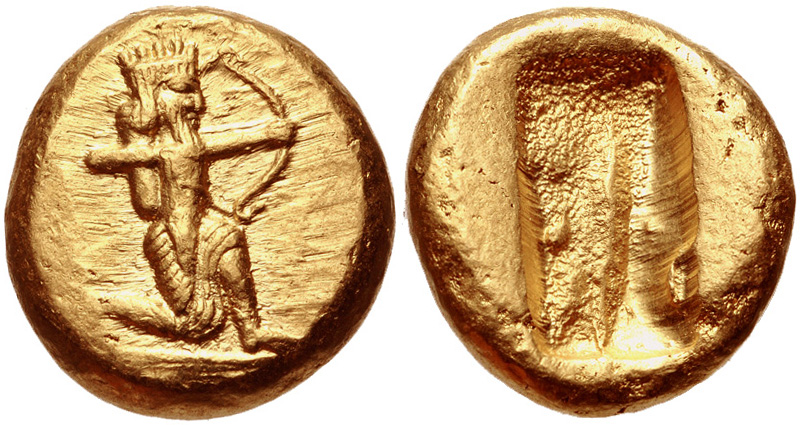
(Full bodied portrait) Type II Daric (“King shooting arrow”) temp. Darios I to Xerxes I. Circa 505-480 BCE, courtesy Wikipedia Creative Commons
History has taught us that power lies at the centre of representation. Take the portrait, for example, a convention that was mostly confined to the elite or royal class, a form of privilege that created presence. A reflection and documentation of the person at that moment in time, it also had the larger purpose, of showing them as absolute, above everyone else. This is something that rulers through the ages have aimed for, using any means necessary. Most evidently by carving their likeness on coins.
In the Indian Subcontinent, images minted on coins started with aniconic forms like sun, hills and swastikas. As societies evolved, religion became the crux of portrayal. We come across several early depictions on coins of deities revered by people in power. That is, until the king himself became the supreme being, the gods’ own chosen hero, or the Rajadhiraja (king of kings). His face replaced those of the gods. The artist depicted an idealistic portrait of the monarch on the obverse, while their deities were shown on the reverse. His face was elevated to a parallel with divinity, with a dash of added heroic elements. But how did this transition happen? What was the catalyst? And how did it evolve?
It was 331 BCE. After their mighty victory over the prodigious Persian Empire, the Macedonian soldiers went eastward, deeper into the Subcontinent. Led by the young and ambitious Alexander, in 326 BCE they crossed the Indus and pierced through what we now call Punjab. A new entity had arrived, and with them, they brought their praxis.
The Persian kings before the 4th century BCE were some of the first to issue coins with full-bodied portraits of rulers with the belief that the king was god’s chosen one. This custom, however, did not have a far-reaching effect. As Alexander brought Darius III to his knees and ended the vast Persian Empire, he changed the course of both history and coin portraiture in the Indian Subcontinent. Persian-style full portraits were replaced with the bust portraits of his Macedonian ancestors. This Hellenistic coin tradition, an extension of the Greek custom of religious portraiture, came to be replaced by regal portraiture on the obverse. This act asserted the identity and dominance of a new ruler over the people.
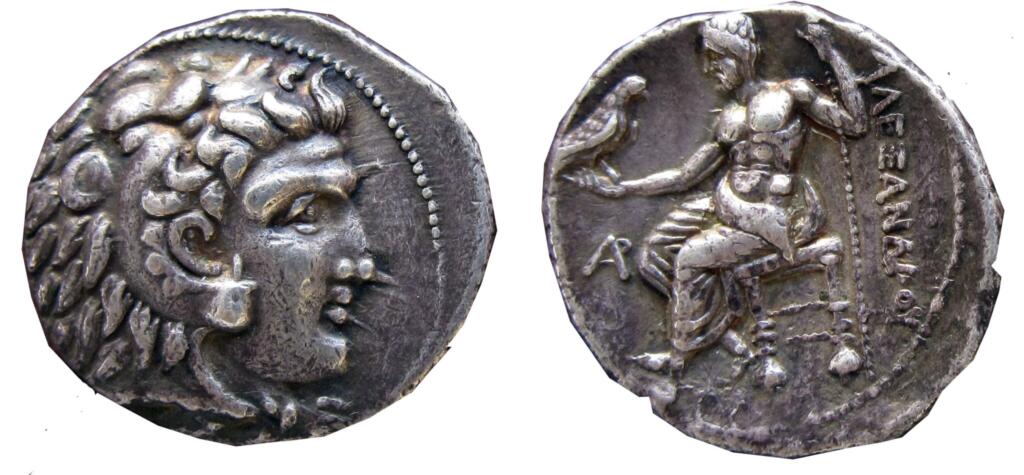
Issued in the name of Alexander the Great, possibly a posthumous issue with the likeness of the Greek hero Hercules on the obverse (image on left), Macedonian Empire, c. 336-323 BCE ⓒ Hinduja Foundation Antiquity Collection
Sir John Marshall accurately described the Bactrian coins as, ‘….designed with a grace and beauty reminiscent of the school of Praxiteles and Lysippus’. Alexander on coins appears as ideal and divine as he was sculpted by the Greek sculptor Lysippos during his official court portrait.
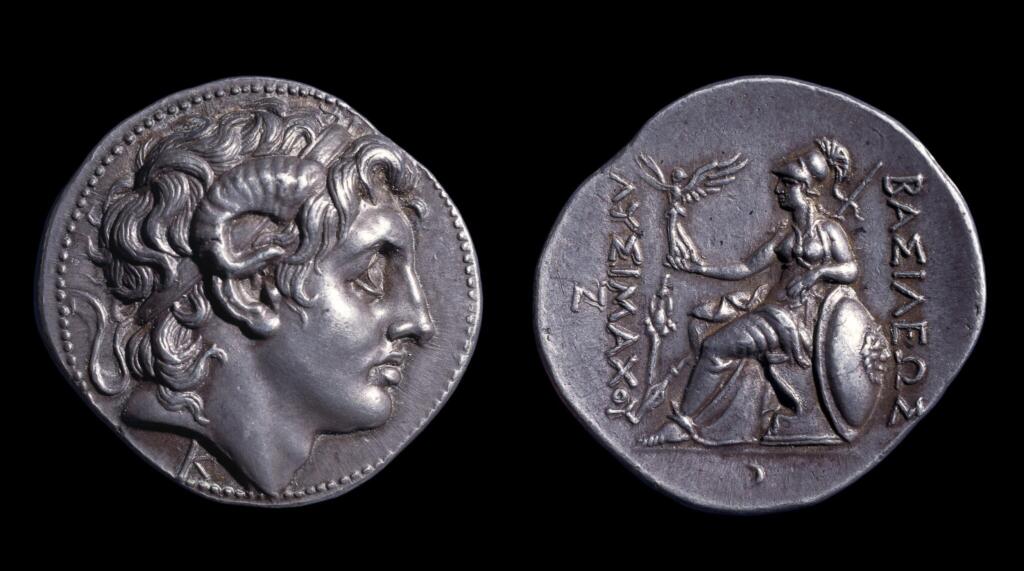
(left) Head of Alexander the Great, diademed and wearing a ram’s horn on a coin issued by King Lysimachus, circa 305-281 BCE, courtesy British Museum—click for source
The coins issued by the Indo-Greeks almost surpassed their Macedonian precedents. These coin portraits elevated the notion of a ruler as the ultimate sovereign, but could they be considered the most truthful depiction of that person? They had a hint of cultivated idealism around them, sculpted in high relief to show the king’s bust with a right profile and a standard diadem (royal headband) with its two ends flowing behind the royal face. Some kings were shown with different types of intricate headdresses, with implied meanings. Coins of Demetrius and Lysias showed them wearing an elephant-scalp headdress, to indicate their Indian conquests, whereas Eukratides is seen wearing helmet-like headgear.
Indo-Greek queens, too, conformed to this tradition. Take Queen Agathokleia, popularly known as Agathokleia Theotropos (110–100 BC), the then regent for her son Strato. Her power was reflected through the coins she issued with her portrait — hair pulled back in a plait and tiny beautiful ringlets of curls on her forehead. A portrait befitting a queen.
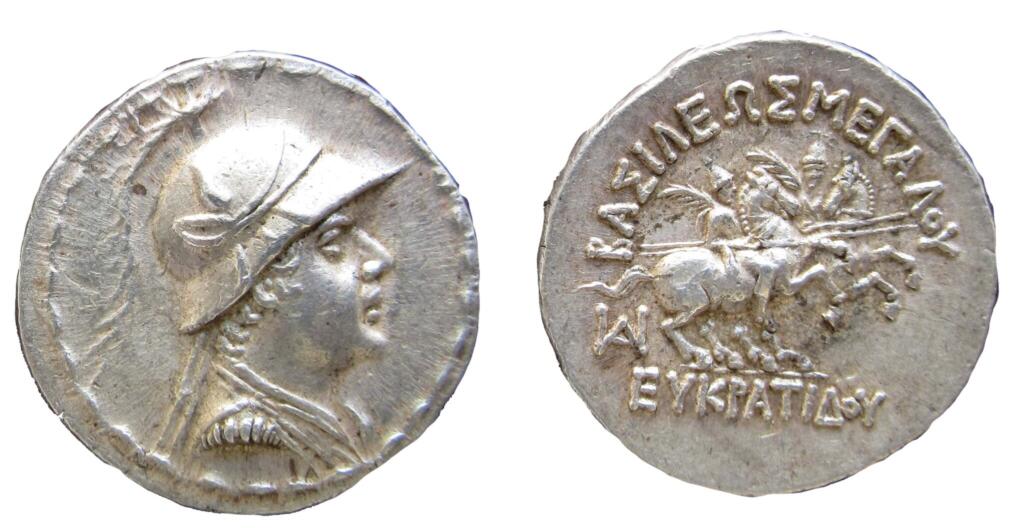
Eukratides I, c. 170-145 BCE ⓒ Hinduja Foundation Antiquity Collection
Upon the advent of Sakas (aka Indo-Scythians, 2nd century BC – 4th century AD), the Bactrian bust was soon replaced by the portrait of a heavily armoured king with a spear on horseback. This became the characteristic marker on Saka coinage. There is even a king on a Bagghi (a two-horse chariot/coach) on some of their issues. Maues issued coins of a seated crossed-legged man, speculated to be Maues himself, and Azes had a portrayal of himself riding a two-humped Bactrian camel holding an ankusa (goad). The Hellenistic norms of a royal portrait on coins were changing, adapting to the change of power.
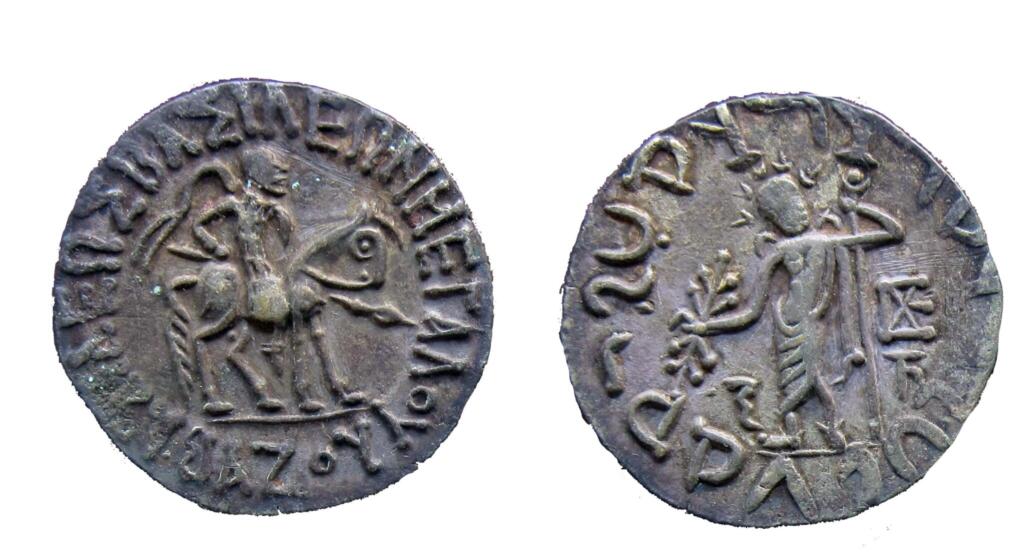
Indo Scythian, Azes I, c.57-35 BCE ⓒ Hinduja Foundation Antiquity Collection
The Western Kshatrapas (especially the Ksharathas), although with Scythian ancestry, issued coinage with neat portraits that imitated the Indo-Greek busts, but with modifications. Nahapana (1st or 2nd century CE), most influential of them all, is shown with a right profile, wearing a flat cap and an upper garment. These ‘King Heads’ differ slightly from the standardized Indo-Greek busts they take after, a feature that scholars say must have been Influenced by the heads on Roman denarii. These Roman coins were circulated and brought to India by the tradesmen and merchants through newly opened maritime trade routes.
Issuing a royal portrait on an everyday means of exchange enlightened the people who used them about their king. It became a medium of communication with their subjects, and sometimes a medium of propaganda. It was imperative, therefore, for every issuer to display his best, most ideal self to gain the trust and adoration of the people he ruled over.
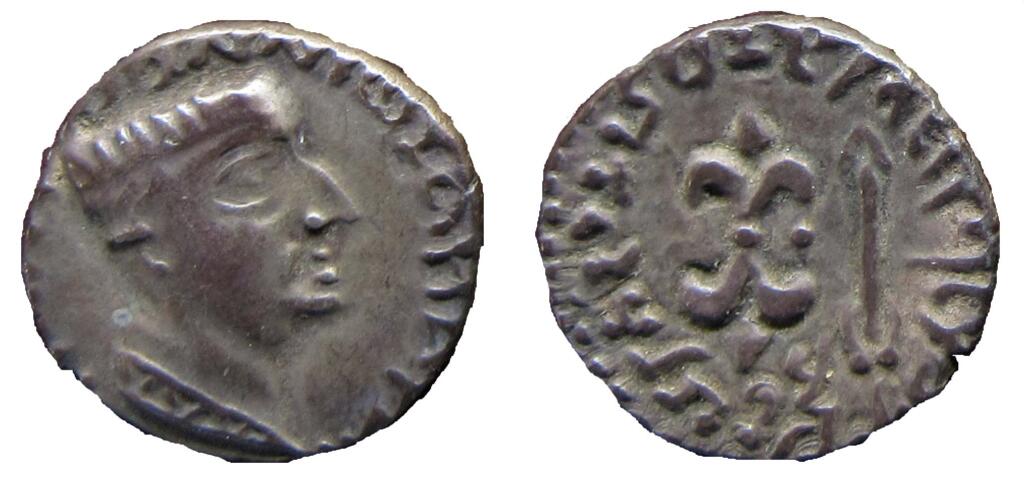
Western Kshatrapa: Kshaharata, Nahapana, c. 1st century AD ⓒ Hinduja Foundation Antiquity Collection
Naturally, coin portraits also served as markers of the dominance of one ruler or dynasty in a specific region. After a victory in battle, the victor would leave no stone unturned to diminish all traces of the losing side. They would counter-strike already circulating coins with their own images. Nahapana was in a constant battle with Gautamiputra Satakarni (1st or 2nd century CE) of the Satavahanas. Silver coins found with Gautamiputra’s portraits counter-struck over Nahapana’s coins tell us about the final defeat of Nahapana and the eventual cold war that followed between these two dynasties for years.
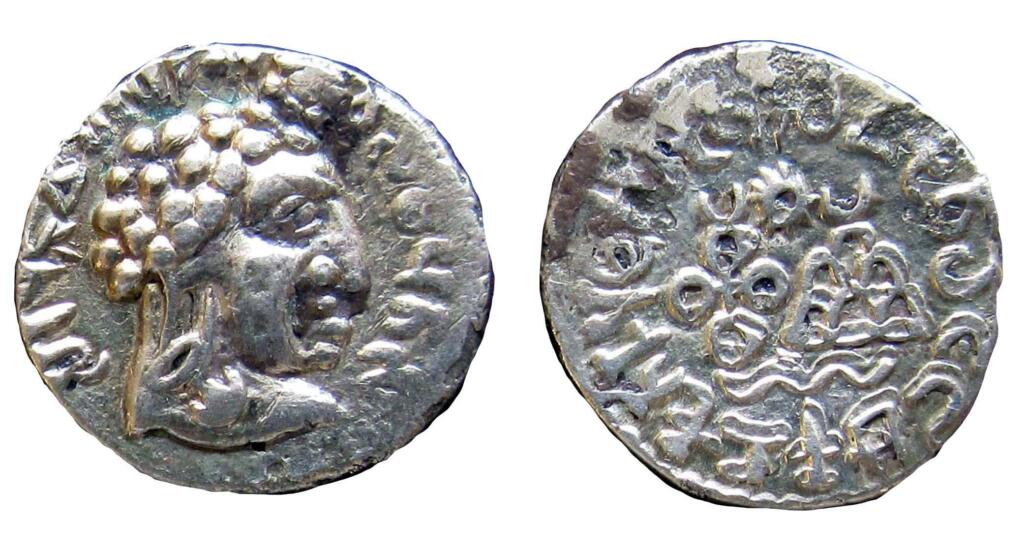
Satavahana, Vasistha Putra Pulumavi, c. 2nd century AD ⓒ Hinduja Foundation Antiquity Collection
The royal portraits on Satavahana coins reveal the changes in aesthetics and features that turn more ‘indigenous’ in the timeline of coinage in our Subcontinent. Mostly issued in silver variants, their facial features are also more lifelike.
While Indologist and art historian VA Smith and numismatist Altekar say that Satavahana portraits on coins are “devoid of any artistic beauty”, archaeologist and historian IK Sharma suggests otherwise. He stresses on their “originality and limited foreign influence”. However, in the royal rumble between Nahapana and Gautamiputra, cultural exchanges and assimilation did not cease. Satavahana portraits on coins were influenced by those of the Kshaharathas, which were already largely influenced by the Indo-Greek Kings. Numismatist AN Lahiri says these coins “are realistic and not idealistic representations of Kings”, which was then a norm set according to Hellenistic standards. You get a glimpse of their curly hair neatly arranged, sometimes in elaborate hairdos, sharp nose, thick lips and heavily detailed earrings or ornaments that one might call indigenous in nature. We also come across these similar indigenous features in many Satavahana sculptures in stone. The local artists had begun to render the tangible domestic and material life of their rulers just as they perceived them, varying vastly from earlier archetypal ones.
This was a period of constant tussle for power and regional or territorial expansion between many rulers locally. Rulers had to appeal to the masses to yield their allegiance to the crown. Perhaps this was the reason for this apparent change in representation on coins.
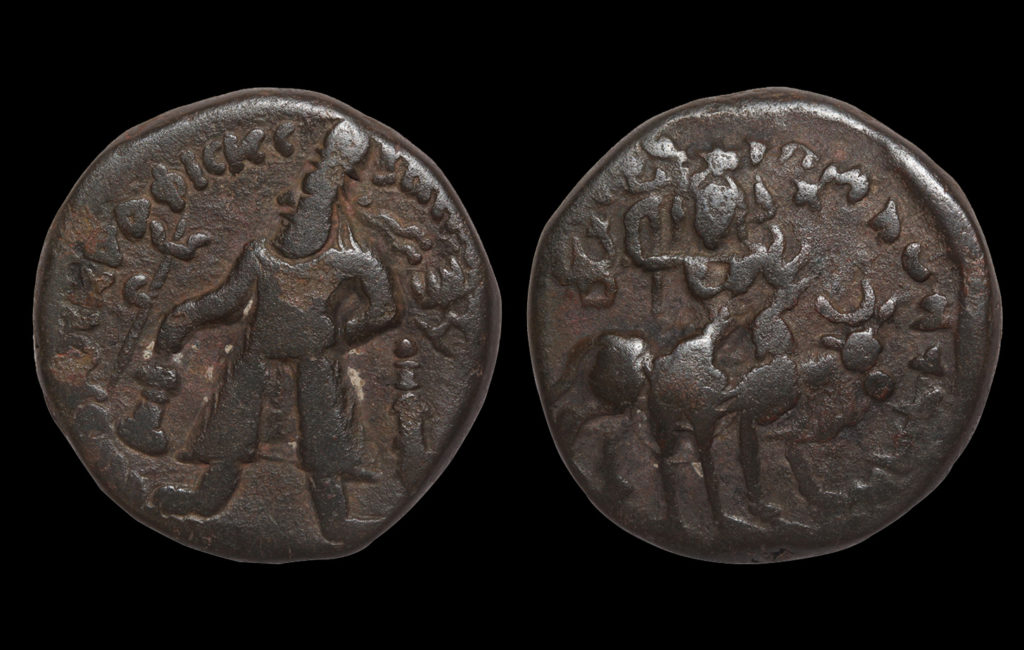
Vima Kadphises, Kushana, c. First quarter of 2nd. Century ⓒ Sarmaya Arts Foundation—click to discover more about this coin
While the Satavahanas enjoyed power in the Deccan, the northwest frontier saw the emergence of the Kushanas (60 CE – 230 CE) or Kouei Shuang, the descendants of the ancient Central Asiatic clan of Yueh-chi. They brought with them peculiar cultural trends, imbibing them into the Indian Subcontinent. This marker defined their royal portraiture on coins. There was an emergence of sewn garments on kings that were central Asian. Tunics, trousers, shorts and boots start popping up on coins, largely defined by the royal class. On his coins, Vima Kadphises appears to be wearing a tunic with a heavy coat, a conical hat and trousers like the Punjabi salwar, with stumpy high boots that seem to denote Tatar boots of Central Asian origin. Rulers also adopted hints of Indian apparel, creating a more syncretic look. Whether this change was done in the interest of the public they were ruling over or themselves is something to ponder upon. But the Kushana portraits certainly showcase stagnant artistic poses, and a lack of fluidity that was gloriously filled by the emerging Guptas (3rd century CE to 543 CE) by their beautiful depictions of portraiture on coins.
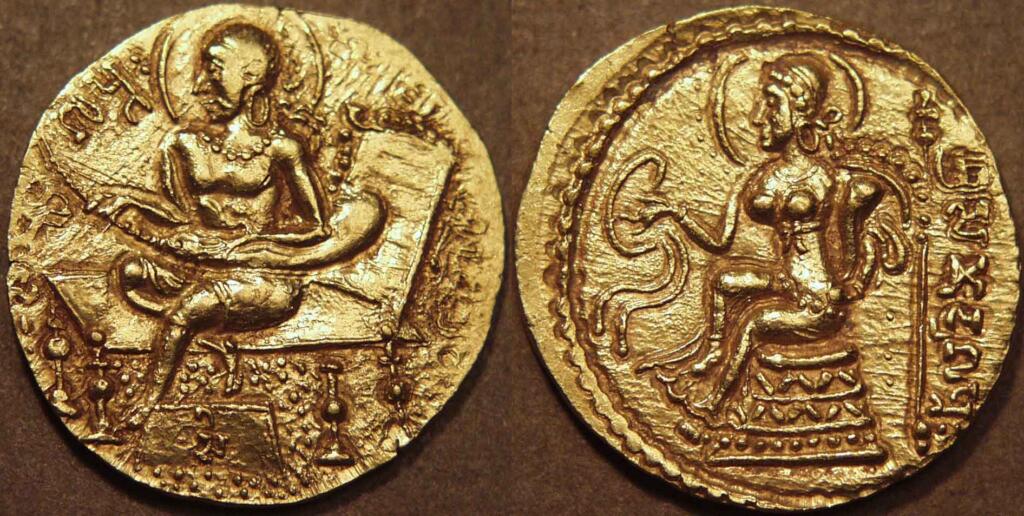
Samudragupta seated on a couch and playing the vina, gold dinar, c. 335-375 CE, from CoinIndia.com—click on the image for source
The early Gupta portraits show a minor lingering of the Kushana influence on Indian royalty in the 3rd – 4th century CE. Stitched garments now became a royal status and the graceful draping of an unstitched garment became a trend. Typical Kushana coats and trousers are visible in early Gupta coin portraits, but they were soon replaced by Indian dhotis. They show lighter boots with buttons as opposed to the heavy Kushana ones. The arrangement of pleats on dhotis and sarees, knotted dupattas and the kamarbandha appealed to local Indian fashion aesthetics of the time. You also find Chandragupta II in a langot (waist cloth). While the Kushanas depicted heavy coats, the Guptas adopted a simpler, lighter version that suited their Gangetic climate.
Historian BN Mukherjee says, “Gliding linear, soft and often sensuous modeling of the body, and a subtle sense of movement characterizes the figures appearing on coins of the Imperial Guptas. Well portioned human figures…the royal figures exude strength, robustness, and vitality.” According to Altekar, “Gupta coins display superb craftsmanship and are masterpieces of design and artistic technique.”
This is true when it comes to the depiction of the domestic, social and material life of these monarchs whose portraits were minted with such grace. The art is quite exemplary. But we must also try and read the meaning that comes with it. Forms and attitudes on these portraits throw light on the various activities and affiliations that Gupta kings took a liking to. Kings were shown fighting a lion or rhino, riding an elephant, playing the lyre, etc. The king, it seems, was not only fearless enough to fight a lion single-handedly, but also possessed sublime artistic talent. The epitome of a perfect ruler. This is what demarcates Gupta portraits from others in terms of representing power through artistic profusion.
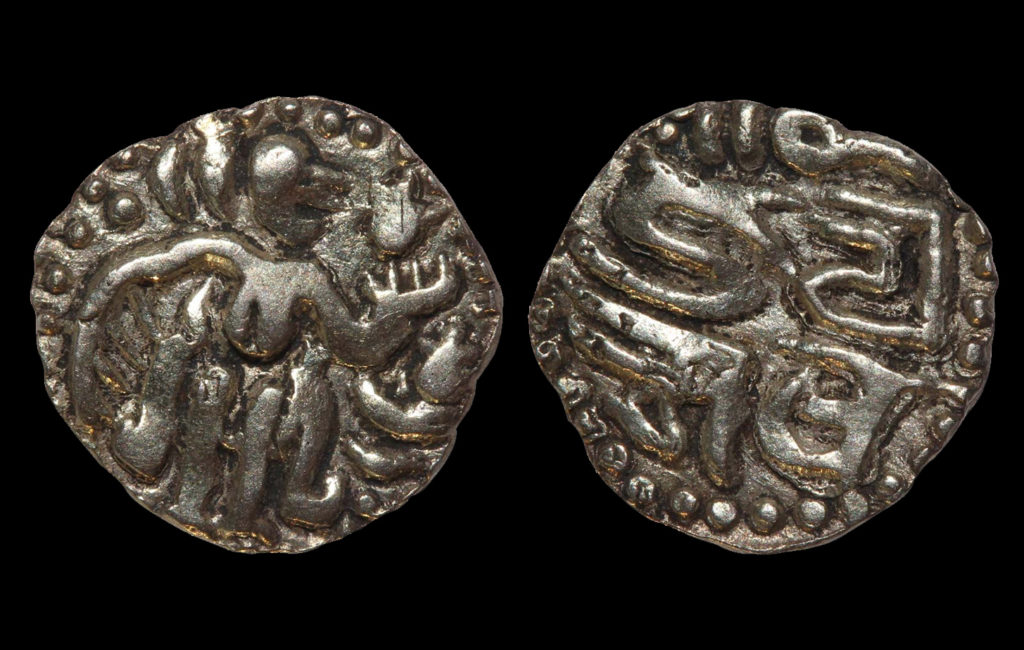
Raja Raja Chola I, Silver Fanam, AD 985 /1014 ⓒ Sarmaya Arts Foundation—click to discover more about this coin
After the Guptas, royal portraiture on coins became less aesthetic, infrequent and quite monotonous. The tradition eventually took a downturn. Perhaps the identity of a ruler as supreme being was being replaced by the identity of an Empire in its entirety. We see a lot of royal crests taking the place of the king’s face. South Indian dynasties, especially the imperial Cholas, did issue a few portraits, but most others stuck to their royal crests on the obverse rather than the image of the king himself. Raja Raja Chola( c. 985–1014) is shown holding a four-hooked mace in his right-hand right and four books on his left. These coins are believed to be influenced by Roman coins in circulation thanks to trade activities in the southern region.
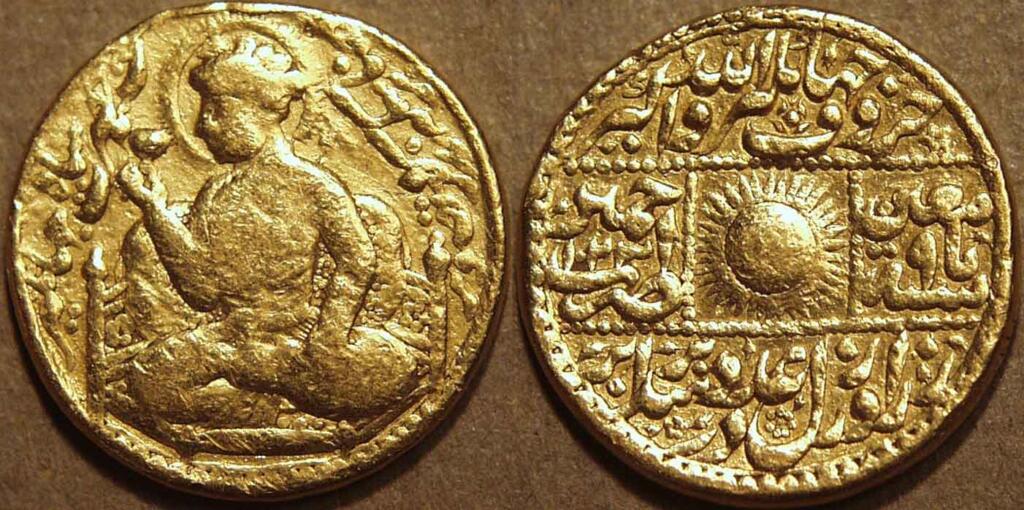
(Jahangir holding a wine goblet) Jahangir (Muhammad Nur-ud-din Salim), 1605-27, Gold mohur, Ajmer from CoinIndia.com—click image for source
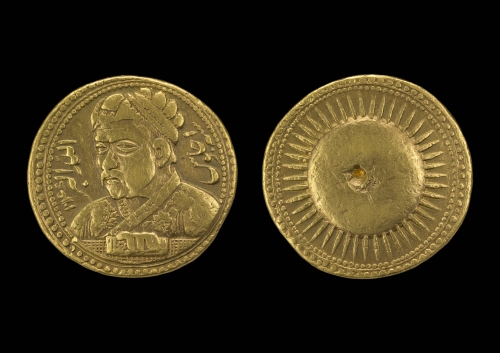
Gold mohur of Jahangir with a portrait of his father Akbar, 1605-1628, Mughal dynasty © The Trustees of the British Museum—click on image for source
Diving to the medieval, Islamic rulers in India mostly issued coins with calligraphic content or aniconic forms. Any pictorial depictions were considered heresy. Though Akbar is considered to be an emperor with secular viewpoints and worldly artistic appreciation, it was his son Jahangir (31 August 1569 – 28 October 1627) who issued portraits on coins, going against Islamic clergy and norms.
According to Numismatist Dr Mahesh Kalra, “These portraits seem to have been influenced by 11th-12th century Central Asian coins. They are life-like, representative of their portraits in miniatures.” Tuzk-e-Jahangiri mentions Akbar’s physical description in the first year of Jehangir’s reign — average height, long arms, broad chest and a mole the size of a chickpea on the left side of his nose. That same year, Jahangir issued a gold mohr with Akbar’s portrait almost identical to the description. Could this royal portrait on coins be most true of all? Reaching the peak of Mughal numismatic art and design, Jahangir also issued a few coins with self-portraits in different embodiments. On one specimen, he wears a turban with an egret and a possibly brocaded dress, holding a book. On another, he is holding a fruit. His most distinguished one is where he is sitting on a throne, a halo around him, and holding a goblet of wine, something that was considered forbidden. Perhaps it was also brave during his time to show himself in such a frame. But these coins were not meant as an everyday means of exchange or currency, and were issued as commemorative gifts given by the Emperor to his faithful followers, who wore them on their headdresses as a decorative piece. One can only imagine the power he held to get away with imagery that broke tradition and went against the orthodox Islamic norm.
Royal portraits continued to be in vogue even during colonial times. British monarchs, too, stamped their supremacy and control over undivided India through coinage. Change came only after India’s independence, when the first official coinage of the Republic of India was introduced in 1950. The portrait of a ruler, a symbol of dominance and power, was finally replaced by the Lion Capital of the Ashokan Pillar — a symbol of peace, prosperity, tolerance and equality.
Bibliography
- Coins of Jahangir – Creations of a Numismatist by Andrew V Liddle
- The Coinage of Ancient India by S. R. Goyal
- Socio – religious & Cultural Study of the Ancient Indian Coins by Swati Chakraborty
- Gupta Numismatics by S. R. Goyal
- Vidya Prakash – Some Aspects of Material Life on Gupta Coins
- Ancient Indian Coins from the Chand Collection.
- The Western Kshatrapas: From Governors to Kings (35 CE – 405 CE)
- QUEEN AGATHOKLEIA ~THE RULER OF AN INDO-GREEK KINGDOM
- ‘Scandalous’ Coins of Jahangir
- Portraits on Coins
- Royal Imagery on Kushan Coins: Local Tradition and Arsacid Influences
- Portraits on coins: A humanising force
- Whitehead, R. B. “THE PORTRAIT MEDALS AND ZODIACAL COINS OF THE EMPEROR JAHĀNGĪR. II. The Zodiacal Coins (Continued).” The Numismatic Chronicle and Journal of the Royal Numismatic Society, vol. 11, no. 42, 1931, pp. 91–130. JSTOR, www.jstor.org/stable/42664263. Accessed 15 Jan. 2021.
- Chakraborty, Surendrakishore. “SOME HINDU ELEMENTS IN MUSLIM COINAGE OF INDIA.” Proceedings of the Indian History Congress, vol. 3, 1939, pp. 672–687. JSTOR, www.jstor.org/stable/44252421. Accessed 15 Jan. 2021.
- COIN OF EMPEROR JAHANGIR
- Portrait Coin of the Emperor Jahangir

